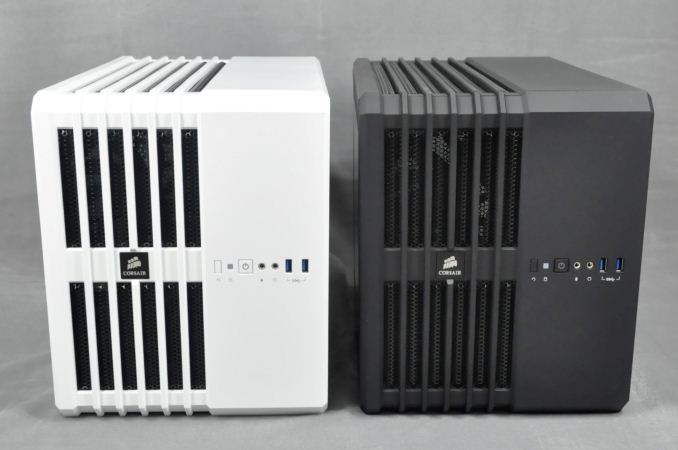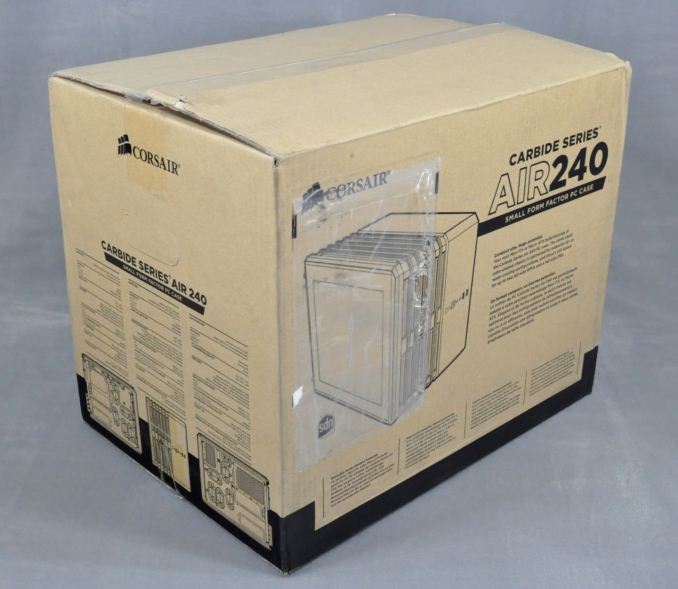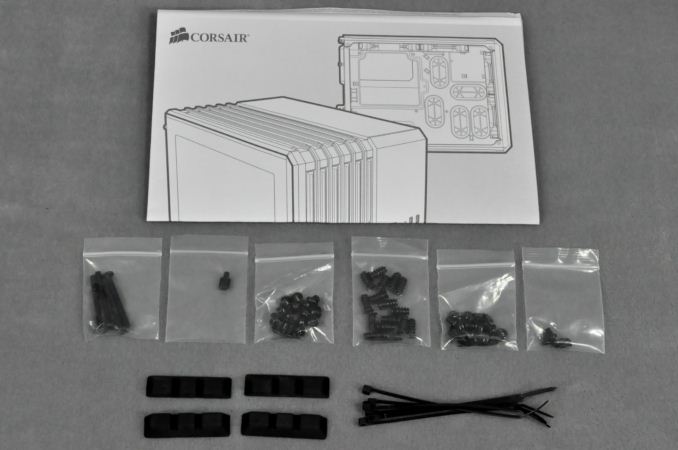Corsair Carbide Air 240 Case Review
by E. Fylladitakis on August 15, 2014 6:00 AM EST- Posted in
- Cases/Cooling/PSUs
- Corsair
- ATX
- Case
- Carbide

Introduction
Corsair is a company originally known for their quality RAM modules, but they have expanded into many other areas of the PC market. Today, Corsair is one of the most important players in the computer hardware market, with the company offering dozens of products, designed to cater to as wide an array of people as possible. Looking just at their computer cases, Corsair offers five series with an ever-expanding number of products, ranging from super-large cases for enthusiasts to low-cost products for budget-driven users. In this review, we will look at one of their latest case designs, the Carbide Air 240.
Compact cases and small form factors are all the rage nowadays. Some companies, such as Silverstone, have focused many of their R&D resources on the development of such designs. The first compact case that we reviewed from Corsair was the Obsidian 250D, a cubic Mini-ITX case of not so compact proportions; instead, it was designed to fit fairly powerful combinations of hardware. This is also true of the Carbide Air 240 that we will be reviewing today. Although it is designed to fit up to Micro-ATX motherboards, the Carbide Air 240 can accommodate very powerful hardware, including two top-tier GPUs and dual liquid cooling radiators. We will look at its design, features, strengths, and weaknesses in this review.
| Corsair Carbide Air 240 Specifications | ||
| Motherboard Form Factor | Mini-ITX, Micro-ATX | |
| Drive Bays | External | - |
| Internal |
3 x 2.5" or 3.5" (rear cage) 3 x 2.5" (top cage) |
|
| Cooling | Front | 2 x 120 (2 x 120mm included) |
| Rear | 2 x 80mm (optional) | |
| Top | 2 x 120mm (one included) | |
| Right Side | 1 x 120mm (optional) | |
| Bottom | 2 x 120 (optional) | |
| I/O Port |
2 × USB 3.0 2 × USB 3.0 1 × Headphone 1 × Mic |
|
| Power Supply Size | ATX | |
| Clearances | HSF | 125mm |
| PSU | 200mm | |
| GPU | 360 mm | |
| Dimensions |
~315mm × 265mm × 400mm (H×W×D) ~12.4in × 10.43in × 15.75in (H×W×D) |
|
| Pricing | ~$90 online | |
Packaging and bundle
The Corsair Carbide Air 240 comes supplied in a simple, brown cardboard box. The artwork on the box is limited to schematics of the case and text. Inside the box, the lightweight case is protected by thick polystyrene foam slabs and is wrapped in a nylon bag.
Corsair kept the items bundled with the Carbide Air 240 down to a minimum but organized them well, supplying each type of screw inside a separate nylon bag. There are also four rubber feet for the case and a few short cable ties.












63 Comments
View All Comments
kyuu - Friday, August 15, 2014 - link
I love the Carbide Air 540, and have been planning on using it for my next build (or perhaps just transplanting my current one, since I've yet to feel compelled to upgrade my overclocked Sandy Bridge system). The idea of a smaller one is great, since the relative girth of the 540 is one of its only drawbacks, as far as I'm concerned.However, the fact that you can't fit radiators unless you go down to a mini-ITX mobo, which only have one PCIe slot I believe, kind of kills it. They also really should have found a way to add a slimline optical drive slot.
Antronman - Friday, August 15, 2014 - link
No 5.25" inch drive bay?I mean, you can't find any room for anywhere in there?
Grok42 - Saturday, August 16, 2014 - link
If they do find room, I hope they add more 3.5" or 2.5" internal bays.notlurking - Sunday, August 17, 2014 - link
Why would you need a few more 3.5" bays? That's what a NAS is for. The Air 540 looks like a great NAS case from the outside but needs a serious redesign on the inside to make it useful in that function.I don't know what Corsair was thinking. There is so much empty space in that case. It looks great on the outside but doesn't work on the inside for any specific role.
DanNeely - Sunday, August 17, 2014 - link
They might be able to fit a slimline above the front fans. Maybe not, it'd be tight due to the 45* bevel on the top edge. The only way they could get a full size bay in without making the case bigger would be to put it in vertically below the 2.5" bays (and shift the front panel connectors around). It'd work for fan controllers or optical drives there; but probably not bay reservoirs. OTOH you could shoehorn in a small non-bay res into that space now.ImSpartacus - Friday, August 15, 2014 - link
It's 2014, why do those graphs have gradient backgrounds?If this was a middle schooler's first powerpoint, then I'd be forgiving. Nope, it's a modern tech blog's technical presentation.
You don't have to have 100% flat diagrams, but a little minimalism could go a long way.
juhatus - Saturday, August 16, 2014 - link
Thanks for great article, again! Few comment:Please post the component listing you used for this? Would be great starting point for build.
Also please post on conclusion what are the main competitors (even few examples) for this case. I´m right about to order something like this with mini-itx, Z97 and 4790k. I´m kind of liking Cooler Master 130 but it would need to be white so no go. I am having really hard time deciding what case to go for :)
know of fence - Saturday, August 16, 2014 - link
A picture with the cooler mounted would be appreciated.People, please stop buying these double shoe-box form factors and closed loop water coolers. Both are inferior alternatives to what is out there: real men buy towers and tower coolers.
This whole market segment exists because people try to be cute and think "out-of-the-box" making the same mistake, but some alternatives just aren't worth considering. A PC goes on the floor where it's least in the way and furthest from one's ears, this thing you could put on a shelf, but wouldn't you rather have the shelf space?
kyuu - Saturday, August 16, 2014 - link
CLC coolers are a perfectly good alternative to giant, heavy air tower coolers. They're also really, really good for cooling GPUs. I'm planning on using a CLC on both my CPU and GPU for my next build.Towers are fine, but cubes work well too, and having two separate compartments for the components like the Air makes a lot of sense. It's also a helluva lot easier to assemble. The 240 is too small, though, unless you're fine with mini-ITX. Have to go with the 540.
juhatus - Sunday, August 17, 2014 - link
If you ask the miss, than you should be buying a ultrabook of the size 11", or why not just buy an IPAD. These are harsh realities some men live. So its mini-itx or ipad, you choose.Ill take mini-itx.